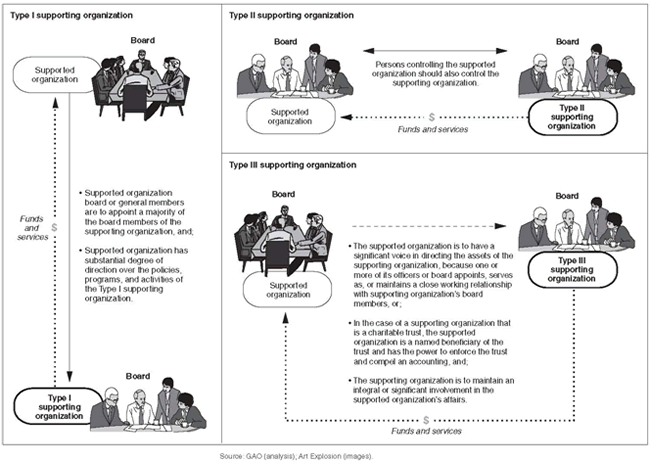FAQ: Supporting Organizations
Summary
A supporting organization qualifies as a public charity because it has a close relationship with another publicly supported section 501(c)(3) organization. Based on the relationship of the supporting organization to the public charity it supports, a supporting organization will be classified as a type I, II or III. Section 1241 of the Pension Protection Act of 2006 (PPA) modifies some of the requirements for how an organization can qualify as a supporting organization.
What is a supporting organization?
Put simply, a supporting organization is a section 501(c)(3) organization that qualifies as a public charity (and not a private foundation) because it has a close relationship with another publicly supported section 501(c)(3) organization. Usually, in order to qualify as a public charity, an organization must receive at least one-third (or in special cases as little as 10 percent) of its support each year from gifts, grants and contributions from a variety of sources. A supporting organization is not required to meet this public support test on its own if it provides meaningful support (financial, programmatic or both) and gives some degree of structural and operational control to another organization that is already classified as a public charity, rather than a private foundation. Based upon the relationship of the supporting organization to the public charity it supports, a supporting organization will be classified as a type I, II or III. A supporting organization may not be controlled by someone who is a disqualified person with respect to the supporting organization.
What are the different classifications of supporting organization?
Generally, supporting organizations fall into three categories: type I, type II and type III. The type indicates the nature of the relationship between the supporting organization and the charity being supported.
- Type I: By far the most common, this type is often described as indicating a parent-subsidiary relationship and generally involves the charity appointing a majority of the board of the supporting organization.
- Type II: The least common of the three, this usually involves an overlapping board relationship where at least a majority of the members of the supporting organization’s board are also members of the supported charity’s board.
- Type III: These operate with a greater degree of independence from the organization they support. Typically the supported organization appoints one member of the governing board of the supporting organization and institutes other procedures designed to ensure that the supporting organization is responsive to it. Type III supporting organizations may provide financial support to their supported organization or they may directly carry out a program or function for it.
Simplified chart of the types of supporting organizations
The chart below is from a report published by the General Accountability Office, “Tax-Exempt Organizations: Collecting More Data on Donor-Advised Funds and Supporting Organizations Could Help Address Compliance Challenges,” GAO-06-799 (July 2006).
The PPA modified the rules for type III supporting organizations organized as trusts subsequent to the publication of the GAO report. The diagram below states the old rule that a supporting organization that is a charitable trust can qualify for type III status if the supported organization is a named beneficiary of the trust and has the power to enforce the trust and compel an accounting. Under the new rules, the power to enforce the trust will not be sufficient to meet the responsiveness test required for type III supporting organizations.

Note that the PPA modified the rules for type III supporting organizations organized as trusts subsequent to the publication of the GAO report. The diagram below states the old rule that a supporting organization that is a charitable trust can qualify for type III status if the supported organization is a named beneficiary of the trust and has the power to enforce the trust and compel an accounting. Under the new rules, the power to enforce the trust will not be sufficient to meet the responsiveness test required for type III supporting organizations.
What is a functionally integrated type III supporting organization?
The PPA includes a subcategory of type III supporting organizations that are considered to be functionally integrated with their supported organizations, and exempts them from several of the additional rules imposed on regular type III supporting organizations.
In general, supporting organizations must meet the “responsiveness” and the “integral part” tests to qualify for type III status. The responsiveness test is meant to guarantee that the supported organization will have the ability to influence the supporting organization’s activities.
The integral part test is intended to demonstrate that the supporting organization is an integral part of the organization it supports. The integral part test can be met one of two ways:
- The supporting organization performs functions of, or carries out purposes of, the supported organization that, but for the supporting organization, the supported organization would engage in directly. For example, a type III supporting organization that operates a printing press for a university would meet this “but for” test if otherwise the university would carry out the activity directly.
- The supporting organization provides funding or other benefits for the supported organization at a level sufficient to ensure that the supported organization will pay significant attention to the operations of the supporting organization. This is called the “attentiveness” test, and it has several other requirements that must be satisfied.
Under the PPA, an organization that satisfies the integral part requirement under the “but for” test is functionally integrated. Organizations that meet the integral part test simply through payments to the supporting organization will not be considered functionally integrated.
Are there requirements under the PPA for qualifying as a type I supporting organization?
Yes, the PPA includes one requirement applicable to type I supporting organizations. An organization will fail to qualify for type I status (and will be converted to private foundation status) if it accepts a gift from a person who directly or indirectly controls the supported organization. In addition, charitable contributions to type I supporting organizations where the donor or advisor controls a supported organization will not be tax-deductible.
Persons who directly or indirectly control the supported organization include:
- Persons (including supporting organizations, but not other publicly-supported charities) who directly or indirectly control, either alone or together with persons described in (2) and (3) below, the governing body of the supported organization
- Family members of an individual described above (spouse, siblings, spouses of siblings, ancestors, lineal descendants, and spouses of lineal descendants)
- Corporations, partnerships, trusts, or estates in which a person described above owns more than 35% of the voting power, profits interest, or beneficial interest
Are there PPA requirements for qualifying as a type II supporting organization?
No.
Are there PPA requirements for qualifying as a type III supporting organization?
Yes, there are several such requirements. First, an organization will fail to qualify for type III status if it accepts a gift from a person who directly or indirectly controls the supported organization (see discussion of changes for type I organizations above). Second, type III supporting organizations must provide such information as the Secretary of the Treasury requires to each supported organization to ensure that the supporting organization is responsive to the needs or demands of the supported organization. Third, type III supporting organizations may not support foreign organizations (existing organizations have three years to comply with this requirement). Finally, under the old rules, a supporting organization that was a charitable trust could qualify for type III status if the supported organization was a named beneficiary of the trust and had the power to enforce the trust and compel an accounting. Under the new rules, the power to enforce the trust will not be sufficient to meet the responsiveness test required for type III supporting organizations. This requirement is effect on date of enactment for new organizations and one year after date of enactment for trusts in existence on date of enactment. The delayed effective date for charitable trusts is to allow the Treasury Department time to promulgate new regulations defining what charitable trusts must do to meet the responsiveness test.
Are the requirements listed above all of the provisions of the Act affecting supporting organizations?
No. The requirements listed above only reflect the provisions that affect how an organization can qualify as a supporting organization. Other provisions affect the operations of supporting organizations. A chart of these other requirements, titled “Provisions Affecting Supporting Organizations,” provides an overview of all changes.
How can I tell if a charity is a supporting organization? How can I tell what type a supporting organization is? How do I determine whether a type III is functionally integrated?
The Council Summary of IRS Interim Guidance on Supporting Organizations and Donor-Advised Funds provides answers to these questions.





